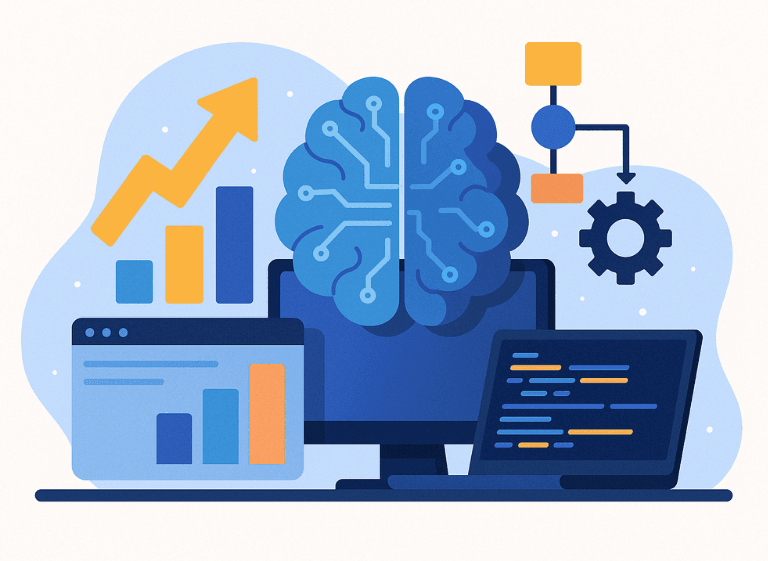AI tools
Web development
DevOps practices
Real project examples
AI in Web Development 2025: Team Roles and CI/CD Automation
Nadiia Sidenko
2025-04-18
AI tools in web development are no longer just a way to write code faster. They’re steadily taking over tasks engineers used to do manually. In 2025, teams that ignore this shift risk falling behind. AI solutions, automated pipelines, and CI/CD systems are now powering everything—from deployment to quality control.

TL;DR
- AI assistants and automated CI/CD pipelines remove routine work and speed up releases without “diving into code.”
- It’s not only about which tools you use but how your processes are organized: mandatory checks, clear quality rules, and a software bill of materials.
- Measure impact with DORA metrics: deployment speed, release frequency, change failure rate, and mean time to recovery.
How AI is changing web development: from autocomplete to infrastructure
AI-powered tools moved far beyond simple code completion. They’re embedding into every stage of delivery—shaping how teams manage work at scale, from coding to deployment and security.
From autocomplete to full automation
What started as line-by-line code hints has become end-to-end integration of AI into the development system. Teams already rely on AI not only for code generation but also for real-time monitoring, automated deployment, and security checks.
Manual development vs AI-assisted process
| Task category | Manual development | AI-assisted process |
|---|---|---|
| Code generation | Hand-written line by line | Context-aware suggestions and templates |
| Testing | Manual setup of test scenarios | AI creates and automatically runs relevant tests |
| Deployment | Custom scripts by DevOps | AI-guided CI/CD with error detection and safe releases with fast rollback |
| Monitoring & alerts | Manually wired 3rd-party services | Integrated predictive monitoring with AI |
| Security checks | After release / ad-hoc | Automated third-party library security checks and code scanning before release |
AI as part of product architecture
Tools like GitHub Copilot are just the surface of more complex systems that interact directly with build tools, surface vulnerabilities, and optimize scripts in real time. The takeaway: AI belongs in your architecture, not merely as a helper plugin.
Roles in AI-era web development: who owns what in 2025
AI doesn’t replace people—it reshapes what they do.
AI changes roles, not headcount
Growing use of AI in software development increases demand for skilled people. AI won’t decide business logic, compliance, or system architecture for you.
From “who writes code” to “who trains and governs AI”
Teams need to rethink workflows. It’s less about who writes which function and more about who trains AI, maintains automated pipelines, and enforces code quality. As shown in our take on scaling after MVP, real growth depends on engineering culture that can run complex systems—not just adopt new tools.
AI pipelines in web development: shipping faster updates
Modern CI/CD isn’t just a delivery mechanism. It behaves like an invisible team member—automating testing, deployment, and monitoring behind every release.
What AI-driven pipelines actually do
Pipelines increasingly act as “invisible contributors” across CI/CD automation, taking on routine tasks—testing, versioning, releases, notifications—so developers can focus on high-impact work.
Key AI-assisted activities:
- Code integration and conflict checks
- Automatic deployment across environments
- Unit and regression testing
- Automated security scanning of third-party libraries
- Real-time performance monitoring
- Alerts and error handling via integrated channels (Slack, Telegram, etc.)
A typical AI-augmented pipeline: 8 steps
1. Build & unit tests → 2. Static analysis — automatic code quality checks → 3. Security scanning of third-party libraries (SCA tools) → 4. Software Bill of Materials (SBOM) for each artifact → 5. E2E/regression tests with prioritization →6. Safe release with quick rollback (blue-green/canary) → 7. Team notifications with required checks → 8. Observability and SLO breach alerts
Impact on business metrics: faster releases and ROI
As we noted in the context of efficiency losses from UX/CRO gaps, weak pipelines delay time-to-market and erode margins. With AI inside the pipeline, build failures or deployment delays are analyzed in seconds—and instantly turned into action.
Case study: Notifix—CI/CD automation in practice
AI delivers measurable results today. One example is a SaaS platform built with automation at its core, where AI augments people instead of replacing them.
What we built and what changed
A SaaS-based platform designed for automation shows how AI fits modern development. The Pinta WebWare team implemented secure Git + SSH integration, automated CI/CD deployments, and Telegram notifications.
Measured outcomes:
- ≈ −40% routine CI/CD work thanks to templates and automation
- ~5 minutes to configure a medium-complexity workflow
- Up to 58 minutes saved per engineer per day
- Parallel task execution and stable performance under load
Metrics worth tracking in a pilot: DORA metrics (lead time, deployment frequency, change failure rate, and mean time to recovery), test coverage, defects per release, mean time to detect, cycle time and work-in-progress, plus cost per release.
Security and AI adoption: risks and control
AI can dramatically raise team efficiency. Without proper controls, though, you can create more problems than you solve—especially in regulated domains like fintech or logistics where incidents are costly.
Automation without control is a risk
Misconfigured pipelines can destabilize systems or compromise integrity. Governance matters as much as tooling.
Skills your team actually needs
Newcomers must learn not only product logic but also AI-integrated environments. Effective developers understand automated tooling, security rules, and responsible AI usage—not just how to write clean code.
Practical security tips:
- Don’t pass credentials (passwords, tokens, keys) in prompts or logs; use secrets management services.
- Generate an SBOM for every release and scan dependencies automatically.
- Keep a prompt log; control personal data and where it’s stored (data residency).
- Enforce least-privilege in CI/CD, enable change auditing, and set mandatory checks before release.
QA with AI: predicting defects before release
AI shifts focus from “fix after” to “prevent before.” By analyzing diffs, commit history, and prior test failures, AI highlights risk-prone areas and runs the right test sets where regression is more likely.
What you gain:
- fewer wasteful test runs → faster feedback loops;
- more stable releases via risk-based testing;
- lower hot-fix costs.
90-Day Roadmap: Start with Confidence
- Readiness assessment: codebase, tests, current CI/CD state.
- Pipeline templates: build/test/SCA/SBOM/deploy/notify.
- Security policies: secrets, logs, access, prompts.
- Pilot with 1–2 teams: one metric framework and quality gates.
- KPI targets: −30% lead time, MTTR < 1 hour, 2–3 releases/day (targets, not promises—compare against your baseline).

Final Thoughts
FAQ
- How do we start with AI in CI/CD safely? Use a non-prod environment, enable required checks, and keep secrets out of prompts.
- Is Copilot OK in regulated industries? Yes—if your data and source policies are aligned with security and contractual requirements.
- How do we calculate ROI? Track DORA + cost per release and saved engineer hours; compare to infra/licenses.
- What is LLMOps in a product? Processes for prompts, guardrails, logging, validation of AI outputs, and access control.
Glossary
- Software Bill of Materials (SBOM): an official list of all libraries and components included in a release.
- Software Composition Analysis (SCA): automated checks of dependencies for known vulnerabilities.
- DORA metrics: deployment speed, how often you release, share of failed changes, and recovery time.
- MTTR (Mean Time to Recovery): average time to restore normal service.
- Blue-green / canary releases: safe rollout strategies that allow quick rollback.
- WIP (Work in Progress): how many tasks are in flight; fewer usually means faster delivery.
- Secrets management (Vault/SSM/Secrets Manager): centralized, secure storage of credentials and keys.
- Data residency: where your data is stored geographically and legally.
- PII (Personally Identifiable Information): data that can identify a person.
- LLMOps: operating practices for AI models in production.
- Guardrails: technical/organizational limits that keep AI within approved boundaries.
- Lead time: time from idea to user-visible release.
- Cycle time: time from starting a task to finishing it.
- Required checks: rules that must pass before merge/release.
- Change failure rate: % of releases that cause incidents.
- Deployment frequency: how often you ship updates.
- SLO alerts: notifications when service quality targets are breached.
Revised in October 2025